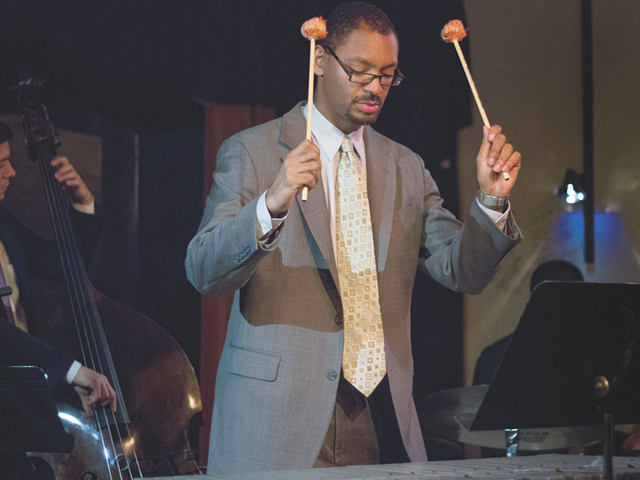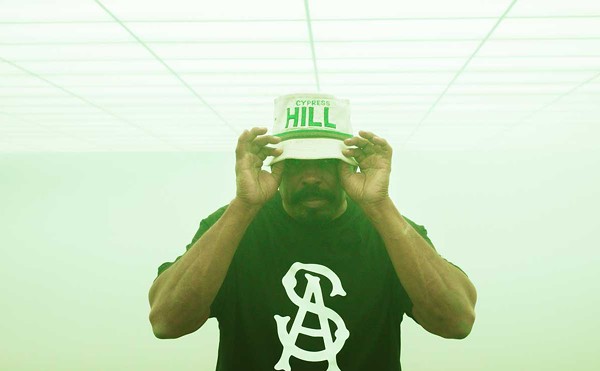Earlier this year, Jack White's Third Man Records successfully launched and played a vinyl record, by Carl Sagan, no less, in outer space.
Meanwhile, back on Earth, Detroit-based theater company A Host of People derives inspiration for Re-Release Party (The Golden Record), their latest performance, from the original record in space: the Golden Record that went along for the ride on the Voyager spacecraft, launched in 1977.
Developed by a team led by Sagan, the record represents a hopeful glimpse of life on Earth to whatever alien might acquire it in a cosmic Discogs score. Along with arcane instructions for extraterrestrial playback, the Golden Record contains greetings in 59 languages, a selection of natural sounds, photos rendered in binary code, and 27 global musical examples, including Mozart, the Mbuti people of the Ituri Rainforest, Blind Willie Johnson, and Chuck Berry.
Something's in the air, and not just wax launched into space. This has been a dense year for quality performance art around Detroit, from the omnibus "Art as Ritual" conference at the Detroit Institute of Arts and Complex Movements' Beware of the Dandelions, to various events that regularly occur at art nodes like Spread Art and Light Box. A Host of People's Re-Release Party promises to add to this rich landscape.
Their productions of the recent past have been site specific, like The Harrowing, which examined urban agriculture at eight Detroit community gardens. In The Modern Woman, A Host of People co-directors Sherrine Azab and Jake Hooker opened up their Southwest Detroit home for a room-by-room performance. Re-Release Party has a more conventional theatrical footprint, and after it launches this month at the Jam Handy, the company hopes to take it on tour. Azab and Hooker sat down to talk with Metro Times about this performance party.
Metro Times: Before we talk about Re-Release Party (The Golden Record), let's talk about your whole endeavor as A Host of People.
Jake Hooker: We essentially make original, completely company-made work, on the spectrum between theater and performance. We blend a lot of different forms: dance, theater, multimedia. These days, luckily, we have a lot of original music in the pieces as well. We make it from scratch. We're a devised company [the theatrical term for their process] and we create work from a proposition of some kind or another and take about, usually, eight months to a year to make a piece, from the inception.
Precariousness is part of the work itself. Not even just in the tech aspects, but in the way we make dance, in the way we deal with text. Even though we rehearse a lot, we're not just performing set-in-stone, inalienable text. We're not doing Shakespeare, we're not doing that thing that's totemic. We're making our own thing, so there is always a kind of intentional precariousness. In the making of the piece, we try so many things, that a lot of the pieces end up being about our effort anyway. All of that energy is bound up in the work.
Sherrine Azab: We don't make documentary theater. This isn't rooted in fact, per se. There are facts about the story, but it's meant to inspire people to learn more about the Golden Record, rather than be the encyclopedic knowledge about the Golden Record.
MT: Where did the concept to work with the Golden Record as subject matter come from?
Azab: I was having a bout of insomnia and I was listening to the podcast On Being. The digital artist and sculptor Dario Robleto was on, talking about a series of works he did in response to the Golden Record. I had heard of the Golden Record but wasn't totally familiar with the process or anything about it, and I thought it was super interesting. I thought that maybe this body of work could be something that we could make a piece of art in response to.
We discovered that Carl Sagan and the whole team that had made that record had written a book about the process called Murmurs of Earth. So we got that book and then veered away from the idea of doing a show that was just in response to the content, and was more in response to the process of making it. It really related to how we make theater. It's an impossible task. You can't make something that represents the entire story of life on Earth on a 90-minute record. And we make a show where we give ourselves an impossible task and what comes out is richer, we think, than setting a lower bar.
Researching more of the story, we discover more drama comes out of the story of making the record. Carl Sagan ends up falling in love with Ann Druyan, who is one of the people who came on the team. So there's a love story embedded in it. The first half, which we call Side A, is the story of making the record, and then we depart from that for Side B. It's more forward-, future-thinking, what we would want to do with the record if we were creating it now.
Hooker: The record is really an artifact of the 1970s, and we are not doing a show about the '70s or even particularly rooted in the '70s. We're invested in hope. We make hopeful work. That doesn't mean we are Pollyannaish about this [present] fucked-up moment, or this fucked-up moment of 1977 either. The record is a totally quixotic, hopeful, bizarre thing to have done.
Azab: They made a conscious decision not to put anything bad about life on Earth on it. We investigate that a little bit further in our show. In some ways it's totally understandable and we do gravitate toward hope, but I think that hope only exists if you show why you're hopeful. There is some timeliness, about some of the things that are happening right now, that I think we would be wrong not to include.
Hooker: We think of hope as an act of resistance.
Azab: There's also something that we talked about really early on with the actors. We were doing some workshoppy interview research, and the conflict between wanting to explore space and re-inscribing colonization was something that we were ambivalent towards as an ensemble. We loved the idea of space travel and space exploration, but are we just re-inscribing what we are notorious for as humans and gets us constantly into trouble? In one sense it's very hopeful, but it could also be very bad.
MT: What about the literal "party" of the event?
Azab: The other part of the company is something that we call our "hosting practice." Every show unfolds into a party. The artists and the audience, without some sort of formal divide, interact with each other and talk to each other. Breaking down the barriers.
Hooker: We open up a space where socializing can happen. It is funny. I was thinking, it's a party and you put on music afterwards. This whole performance is about this curated musical experience. What music are we going to play for the party!? But I think it's important to say, "Stay here with us for a while."
A Host of People's Re-Release Party (The Golden Record) premieres Friday, Nov. 4 at the Jam Handy; Starts at 8 p.m.; 2900 E. Grand Blvd., Detroit; general admission is $15. Performances continue on Nov. 5, 10-12, 17-19, all at 8 p.m. Special Pay-What-You-Will Performance Tuesday, Nov. 15 at 8 p.m. Info and tickets at ahostofpeople.org.





